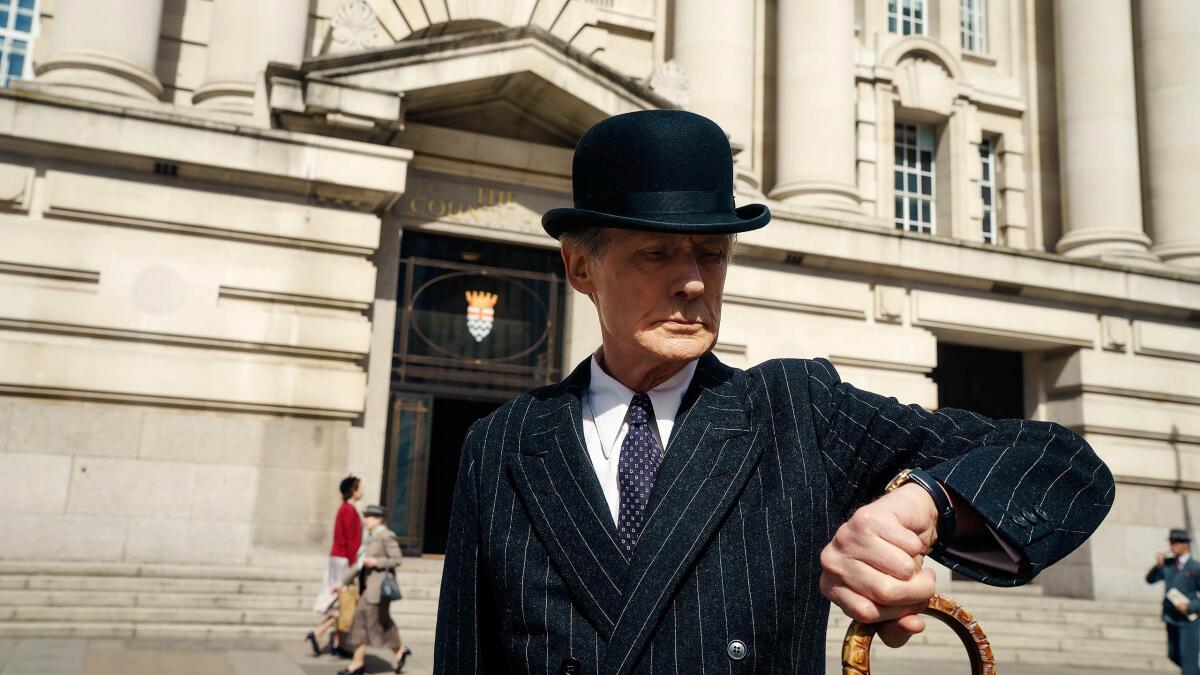If you doubted the greatness of Bill Nighy, a moving new drama offers ‘Living’ proof

- Share via
Not long into “Living,” Mr. Williams learns that he has not long to live. The news doesn’t come as a huge shock, but even if it did, you gather, nothing about this man — not his stiff posture, his calmly appraising gaze or his thin, flat line of a mouth — would betray anything resembling devastation or even surprise. We are in 1950s London, and Mr. Williams, who’s spent more than two decades toiling away in the county hall’s Public Works department, has encased himself in a shell of propriety, receiving every new document and file with unfailing politeness and unflappable calm. Why should his response to his own demise — in six months to a year, max — be any different?
Here it should be noted that Mr. Williams is played by Bill Nighy, for whom a show of restraint is never just a show of restraint. Within emotional parameters that other actors might have found gloomily constricting, Nighy coaxes forth a tour de force of understatement, suffused with an almost musical melancholy. His performance, which won a lead acting prize from the Los Angeles Film Critics Assn. earlier this month, is a gorgeous minor-key symphony of downcast gazes and soft-spoken pronouncements, lightened occasionally by a faint little ghost of a smile. There’s a whisper of humor to Mr. Williams, a sense of irony about a death sentence that he keeps secret from all but a trusted few. In the movie’s best moments, Nighy lures you into the impression that he’s sharing a private joke with you, a glimmer of comic insight into an unbearably sad situation.
For your safety
The Times is committed to reviewing theatrical film releases during the COVID-19 pandemic. Because moviegoing carries risks during this time, we remind readers to follow health and safety guidelines as outlined by the CDC and local health officials.
At one point you might flash back to “Love Actually,” specifically a line from one of Nighy’s funniest, most famous performances: “And now I’m left with no one, wrinkled and alone!” But Mr. Williams is not one for flamboyant self-pity, and “Living,” thankfully, will never be mistaken for “Life Actually.” Exquisitely directed by Oliver Hermanus from a spare, elegant script by the Nobel Prize-winning novelist Kazuo Ishiguro, the movie is a faithful English-language reimagining of “Ikiru,” Akira Kurosawa’s 1952 film about a Tokyo widower who receives a terminal stomach-cancer diagnosis and turns over a startling new leaf.
An emotional epic situated between more sweeping Kurosawa classics (it was made after “Rashomon” and right before “Seven Samurai”), “Ikiru” remains sufficiently revered that the mere thought of a remake might draw cries of sacrilege. But it is also, like so many of Kurosawa’s films, a culturally permeable, infinitely adaptable story. (“Ikiru” itself was loosely drawn from Leo Tolstoy’s novella “The Death of Ivan Ilyich.”) Its lessons about the finity of existence and the beauty of living for the good of others are nothing if not universally applicable, something that could also be said of its withering indictment of government bureaucracy.

In “Living,” that bureaucracy has been transplanted to postwar London and visualized as a sea of gray pinstripe suits and bowler hats, flowing through wood-paneled offices and up and down marbled stairwells. It’s an almost distractingly beautiful vision of workplace tedium, thanks to the impeccable cut of Sandy Powell’s costumes, the polish of Helen Scott’s production design and the deep colors and sharply planed images of Jamie Ramsay’s cinematography. Our first impressions of the place, and of Mr. Williams himself, come by way of a new Public Works hire, Peter Wakeling (an excellent Alex Sharp). His cheery disposition and idealistic spirit are swiftly tempered by the realization of what their work, if that’s the word, entails.
The building is a well-ordered monument to inefficiency, where papers are duly stored and shuffled around, and anyone in need of personal assistance is immediately referred to the next department over. The satire of public administration is much the same as it was in “Ikiru,” down to the series of wipes used here (by editor Chris Wyatt) to follow a group of women on their fruitless, frustrating quest to convert a bomb site into a children’s playground. But Ishiguro has also streamlined the material and sanded down some of its rougher edges, in keeping with a sensibility that feels governed by a quintessentially (or perhaps just stereotypically) English reserve. In “Ikiru,” a doctor lies to his terminally ill patients, claiming they only have an ulcer; in “Living,” bad news is delivered and processed with the stiffest of upper lips.
That makes for a trimmer narrative (40 minutes shorter than the original), if also one that, for those who’ve seen “Ikiru,” might feel a touch muffled and overly circumscribed as it sends Mr. Williams off in search of existential answers. Away he goes from the office where he has never missed a day’s work until now, with nary a word to his colleagues or to his unsuspecting, self-absorbed son (Barney Fishwick) and daughter-in-law (Patsy Ferran). His chance encounter with a worldly pleasure seeker (Tom Burke) is diverting enough, though their guided tour of arcades and nightclubs has been conspicuously denuded of suspense or menace. More affecting are Mr. Williams’ moments with a soon-to-be-former colleague, Margaret Harris (a delightful Aimee Lou Wood), whose warmth and good humor make her an ideal if accidental confidant.

Their tender rapport is one of the story’s pleasures — a reminder that the gradual forging of a bond between near-strangers, truthful and unhurried, can be one of the simplest and most powerful things to witness in a movie. Their meetings also never rise above a polite simmer, which is true of nearly everything that transpires in “Living,” death included. In “Ikiru,” the great Takashi Shimura externalized his character’s desperation with enormous, wide-open eyes and a drooping stare. Nighy forges something more mysterious, almost subterranean, from Mr. Williams’ crisis and sudden reawakening.
That might make the movie sound more anemic than it plays, as if it were a story about the meaning of life with barely enough life surging through its own veins. But if “Living” never matches — or tries to match — the grit and density of Kurosawa’s masterpiece, it knows that detachment can be deceptive, that it can conceal profound and resonant depths of feeling. Ishiguro, who knows a thing or two about the subtle braiding of Japanese and English sensibilities, has mastered the art of such concealment in his own fiction, notably his famously filmed novel “The Remains of the Day.” Hermanus, a South African filmmaker known for his tense and powerful dramas of gay desire (“Beauty,” “Moffie”), has similar form when it comes to dramatizing repression.
Their economy comes to fruition in the third act of “Living,” which shrewdly restructures the story’s closing scenes with no loss of impact, and with an assertion of its own singular identity. That’s to the good of a movie that knows Mr. Williams’ example is somehow both admirable and inimitable, that the difference between an ordinary life and an extraordinary one can only be measured within a set of specific, unrepeatable circumstances. It’s only human to pretend we would behave as our heroes would, and no less human to long to see and hear their stories retold.
‘Living’
Rated: PG-13, for some suggestive material and smoking
Running time: 1 hour, 42 minutes
Playing: Starts Dec. 23 at Laemmle Royal, West Los Angeles
More to Read
Only good movies
Get the Indie Focus newsletter, Mark Olsen's weekly guide to the world of cinema.
You may occasionally receive promotional content from the Los Angeles Times.







